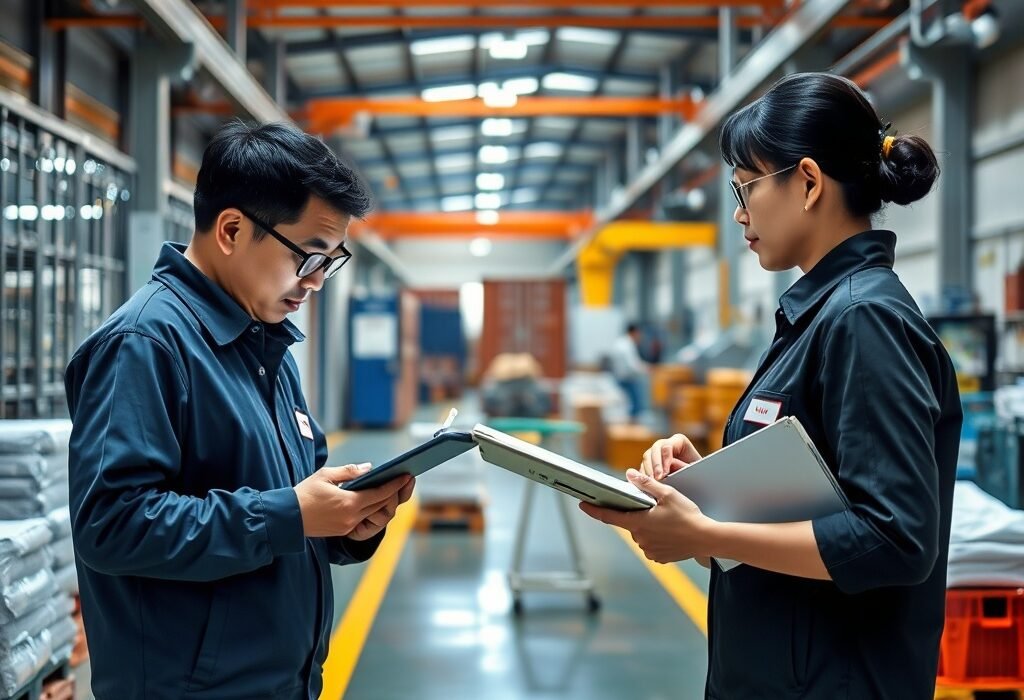⏱️ Reading time: 7 min
Sourcing products from China can be profitable — but also risky if you don’t know who you’re buying from. Thousands of new “suppliers” appear online every month, and not all of them are legitimate factories. A single mistake can mean defective goods, lost payments, or fake documentation.
This guide explains how to verify Chinese factory step-by-step, so you can deal confidently with real manufacturers, not unreliable middlemen.
Why Factory Verification Matters More Than Ever
Before placing an order, you must know who you’re really dealing with — a factory, a trading company, or a reseller.
Factory verification helps you:
- Confirm production capability and equipment
- Validate legal business registration
- Check compliance with export standards (ISO, CE, FCC, RoHS)
- Avoid scams and payment fraud
- Build long-term OEM/ODM partnerships
📎 Related post: How to Buy Directly from Chinese Factories
🧾 Step-by-Step Process to Verify a Chinese Factory
Step 1 – Check Business License and Legal Name
Ask the supplier for a scanned copy of their business license (“营业执照”). Verify the company name, address, and registered capital via the Chinese National Enterprise Credit Information Publicity System (NECIPS).
You can check it online: https://www.gsxt.gov.cn/
✅ Ensure the registered scope matches your product type (e.g., “electronics manufacturing,” “machinery parts”).
Step 2 – Analyze Factory Location and Address
Compare the address on their license with what’s shown on Google Maps, Baidu Maps, or any logistics label they share.
Factories in industrial zones or manufacturing parks are real; office towers often indicate traders.
Tip: Ask for factory exterior photos or a live video walkthrough.
Step 3 – Review Export Experience and Certifications
Request certificates such as:
- ISO 9001 (quality management)
- CE / RoHS (for electronics)
- BSCI / Sedex (ethical manufacturing)
- Product test reports or past export invoices
⚠️ Verify these certificates with issuing bodies or via QR/barcode scans. Fake PDFs are common.
Step 4 – Conduct a Third-Party Audit
Hire professional inspection firms (e.g., QIMA, SGS, TÜV, Bureau Veritas) to perform:
- Factory audit (machinery, workers, QC process)
- Pre-shipment inspection
- Container loading check
Typical audit fees range from USD 200–350, but it’s the best insurance for large orders.
Step 5 – Request a Live Video Call or Virtual Tour
Ask the factory to show you:
- Assembly line
- Warehouse
- Packaging section
- Company signboard and staff
Real manufacturers will gladly do this.
If they refuse or stall, it’s often a red flag.
Step 6 – Request Samples and Compare Details
Always order a sample before bulk production. Compare:
- Material quality
- Packaging accuracy
- Branding consistency
- Dimensions and finish
This is also a chance to test communication speed and honesty.
Step 7 – Cross-Check with Other Buyers or Platforms
Search for factory names on:
- Alibaba or Made-in-China (see profile type: manufacturer or trader)
- Global Sources
- Trustpilot or import forums
Join LinkedIn groups for “China sourcing professionals” — often someone has dealt with that supplier before.
📊 Verification Checklist Summary
| Step | Action | Purpose |
|---|---|---|
| 1 | Verify license on gsxt.gov.cn | Legal validation |
| 2 | Confirm location & photos | Ensure factory existence |
| 3 | Check certifications | Confirm compliance |
| 4 | Third-party audit | Confirm quality & scale |
| 5 | Live video tour | Visual confirmation |
| 6 | Request samples | Product quality proof |
| 7 | Cross-check online | Reputation check |
🤝 When to Use a Sourcing Agent
If you don’t speak Chinese or need multiple product types, hiring a trusted sourcing agent can help.
They can perform factory visits, consolidate shipments, and communicate directly in Mandarin — saving time and risk.
Make sure your agent provides transparent reports and proof of direct factory deals.
📦 Secure Your First Order the Right Way
Once you verify a factory, start small.
Use safe payment methods (like Trade Assurance, PayPal for samples, or T/T after inspection) and get a purchase contract in both English and Chinese.
Clarity upfront builds long-term partnerships — not costly misunderstandings.
📎 Next: Safe Payment Methods When Buying from China
🧠 Key Takeaways
- Always verify factory identity and location.
- Never skip sample evaluation and audits.
- Use third-party inspections before mass payment.
- Avoid middlemen claiming to be “manufacturers.”
- Real factories welcome transparency.
🔍 FAQs: How to Identify Reliable Chinese Manufacturers
1. How can I verify if a Chinese manufacturer is legitimate?
Check the company’s business license, registration number, and factory address through China’s official platforms like the National Enterprise Credit Information Publicity System. Also, request ISO certifications and conduct video calls to confirm facilities.
2. What’s the best way to avoid scams when sourcing from China?
Always use verified B2B platforms (like Alibaba, Global Sources, or China Wholesale Hub), perform supplier audits, and avoid upfront full payments. Use escrow or Trade Assurance for secure transactions.
3. How can I check a supplier’s production capacity?
Ask for factory photos, machine lists, and production records. Reliable suppliers can show you OEM/ODM projects, product certifications, and export history that prove consistent output quality.
4. Are sourcing agents helpful when finding Chinese factories?
Yes, sourcing agents can bridge communication, negotiate pricing, and inspect factories locally. They are especially helpful for first-time buyers who need quality control and logistics management.
5. What documents should I request from Chinese manufacturers?
Request the business license, export license, product test reports (CE, RoHS, etc.), and customs clearance records. This helps verify legitimacy and compliance.
6. How can I ensure the manufacturer’s product quality?
Perform sample testing, hire third-party inspection services, and use pre-shipment quality checks. A reliable factory will agree to quality assurance clauses in contracts.
7. What red flags indicate a fake Chinese supplier?
Be cautious if the supplier avoids video meetings, uses free email domains, cannot show their factory, or offers prices far below market rates. These are often warning signs of fraudulent activity.
8. Should I visit the factory in China before placing large orders?
If possible, yes. Factory visits allow you to inspect production lines, meet management, and confirm ethical working conditions—a key step for long-term partnerships.
9. How do language barriers affect sourcing from China?
Most reliable manufacturers have English-speaking sales teams, but misunderstandings can still occur. Use clear written communication, avoid idioms, and confirm every technical specification in writing.
10. Can I find Chinese manufacturers without using Alibaba?
Absolutely. Platforms like China Wholesale Hub, Made-in-China, and Global Sources connect buyers with factory-direct suppliers and verified exporters, offering safer and more transparent sourcing options.
11. What is the difference between a manufacturer and a trading company?
A manufacturer owns production facilities, while a trading company acts as a middleman. Manufacturers usually offer lower prices, but trading companies can provide a wider product range and better communication.
12. How can I build long-term partnerships with Chinese manufacturers?
Be consistent, pay on time, and share feedback constructively. Strong relationships lead to priority pricing, better quality, and exclusive deals for loyal customers.
13. How important are factory audits in China?
Extremely important. Factory audits verify compliance, safety standards, and production reliability. You can hire third-party agencies for professional audits and detailed reports.
14. Where can I find pre-verified Chinese factories online?
Visit China Wholesale Hub, which lists verified manufacturers with detailed factory insights, certificates, and contact details to ensure safe and direct sourcing.
About ChinaWholesaleHub
ChinaWholesaleHub is a factory-focused global sourcing platform that connects international buyers directly with verified Chinese manufacturers for OEM/ODM production and factory-direct pricing. We vet export-ready factories, simplify communications, and provide end-to-end sourcing support — from supplier checks and sample coordination to quality control and logistics — so brands, retailers, and importers can scale with confidence and lower costs while retaining full control over product design and supply chain.


